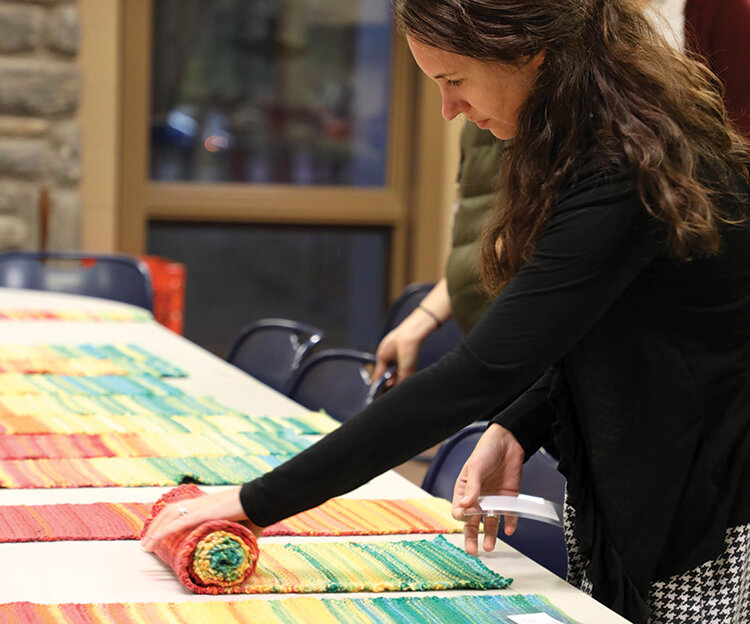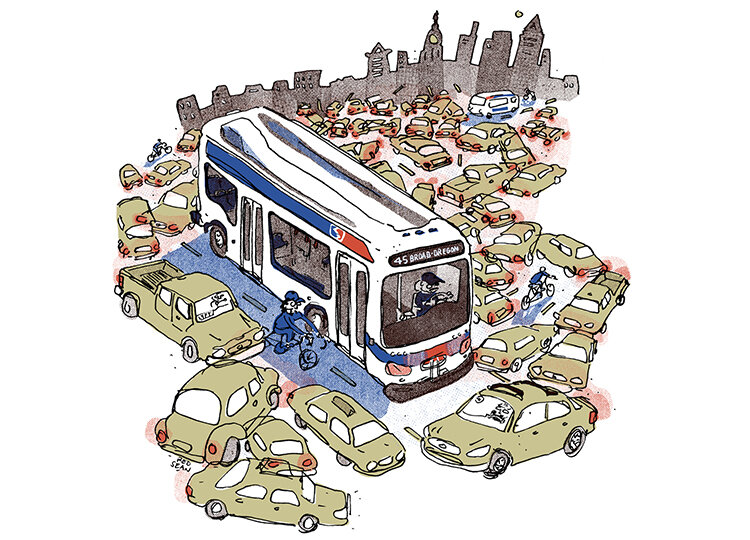Photo Courtesy of Liz Jelsomine
By Jimmy McGinley Smith
During the early Industrial Revolution a pithy aphorism was coined to express the urgency and practical need to address a problem: “A stitch in time saves nine.”
The 18th century adage was brought to life this week by knitters and chrocheters from across the country, a collection of craftsmen and women that included 38 Philadelphia-area knitters, all stitching a colorful and cautionary message that our global climate is facing an environmental crisis.
On Thursday, December 12th, the Schuylkill Center—located in the Roxborough section of the city—unveiled Philadelphia’s own “Tempestry Project,” an ornate band of tapestries that visualized—through knitted fibers—a portrait of global climate data.
According to a statement from Christina Catanese, Director of Environmental Art at the Schuylkill Center, “It took thirty-eight volunteers knitting 750,000 stitches, about 8 miles of yarn, and countless hours to complete the collection.”
Within each temperature tapestry or Tempestry, the daily high temperatures for a given year are shown from January to December. Each of the nationwide Tempestries use the same yarn and colors and temperature ranges, creating what Ms. Catanese described as a “globally comparable mosaic of shifting temperatures.”
The Tempestries fit into a time frame stretching from the years 1875 to 2018, uniting crafters from around the world who have created hundreds of these similarly instructive and fluid temperature tapestries.
At least four different scientific organizations that follow temperature trends have concurred: 2018 ranked as the fourth warmest year on record. The four research bodies, NASA, Berkeley Earth, the United Kingdom’s Hadley Centre and the Japan Meteorological Agency—accumulating data based on varied methodologies—each arrived at the same alarming conclusions regarding the warming climate, bringing something close to unanimity on the data.
Since the year 2000, according to NASA’S finding, 18 of the 19 warmest years have occurred globally, resulting in a variety of extreme weather conditions. In 2018 alone, hurricanes and wildfires claimed nearly 250 lives, costing nearly $100 billion in damages.
Crafters from around the world created these “Tempestries,” which depict global temperature data stretching from 1875 to 2018. | Photo Courtesy of Liz Jelsomine
Although the four research institutions used different technological tools in measuring land and ocean temperatures, their findings were that there exists an irrefutable global warming trend. The Tempestry Project’s global data visualization reiterates a similarly disturbing message through textile or fiber arts. All Tempesties or temperature tapestries, using a varied color scheme of yarns, depict the temperature ranges for a given year.
Looking at climate change in Philadelphia—as elsewhere, largely the result of greenhouse gas emissions—a pattern of hotter and wetter weather is emerging, with more flooding from increasingly intense storms.
Moreover, the shift in climate is producing a variety of negative implications for human health and ecology, as well as the safety of the region’s infrastructure.
Since 2010 Philadelphia has experienced a number of record-breaking weather events: among them, the two warmest summers on record, including 2010, when Philadelphia had 55 days of above 90 degrees and 17 days above 95 degrees.
By contrast, the Schuylkill Center’s Tempestry for the year 1875, crocheted by Lauren Bessler, reveals that Philadelphia’s highest daily maximum temperature was one day of 95 degrees, occurring on June 25th.
Leaping to our current era, the Tempestry created by Jessica Griffith for the year 2018 reveals -with a fiery cranberry color- that Philadelphia’s highest daily maximum temperature occurred on July 3rd, when it climbed to a staggering 101 degrees Fahrenheit.
Between 1970 and 2018, Philadelphia averaged 28 days above 90 degrees per year. But according to climatologists, by the year 2080, Philadelphia could have up to 100 such days of 90 degree-plus days.
Photo Courtesy of Liz Jelsomine
Besides the troubling trend to warming temperatures, the Philadelphia region and the globe is also experiencing fewer cold days. In 1875, for instance, there were 30 days with high temperatures that never rose above freezing. Yet by 2018, there were only 9 such frigid days. The evidence of this is mirrored in the changing colors of Tempestries for those respective years.
The Tempestry Project was spearheaded by Justin Connelly, Marissa Connelly and Emily McNeil of Anacortes, WA. Along with Philadelphia, hundreds of other Tempestries have been made by crafters around the world.
Located on what was originally farmland in the northwest section of the city , the 340 acre Schuylkill Center was founded in 1965, and is one of the first urban environmental education centers in the county.
With the goal of allowing city residents to experience the wonders of nature, the center, located near Ridge Avenue and Hagy’s Mill Road, includes a rich expanse of fields, forests, streams, ponds, along with being fronted by a collection of solar panels.
In addition to the Tempestries Environmental Art exhibit, the Schuylkill Center is open Monday to Saturday, 9:00am to 5:00 pm and welcomes visitors ranging in ages from kindergarten to college students and seniors. The center has specific environmental programs targeting preschool and kindergarten children, enabling them to interact with native birds, butterflies and frogs and explore nearby forests and ponds.












